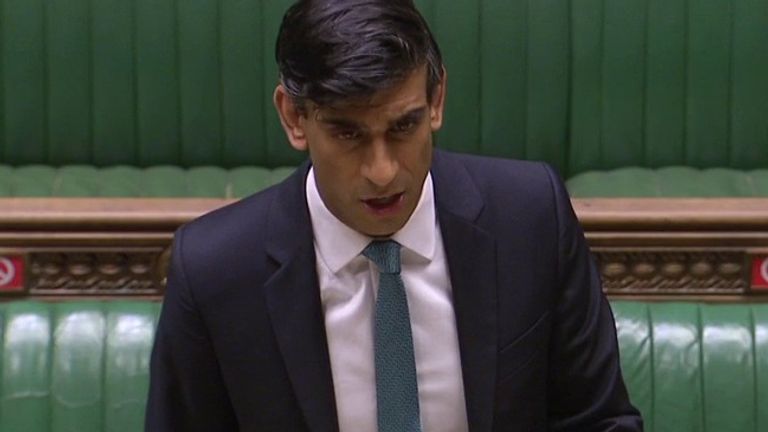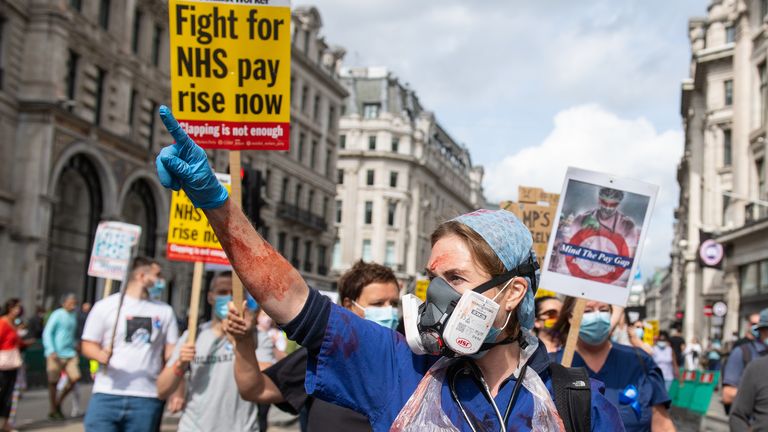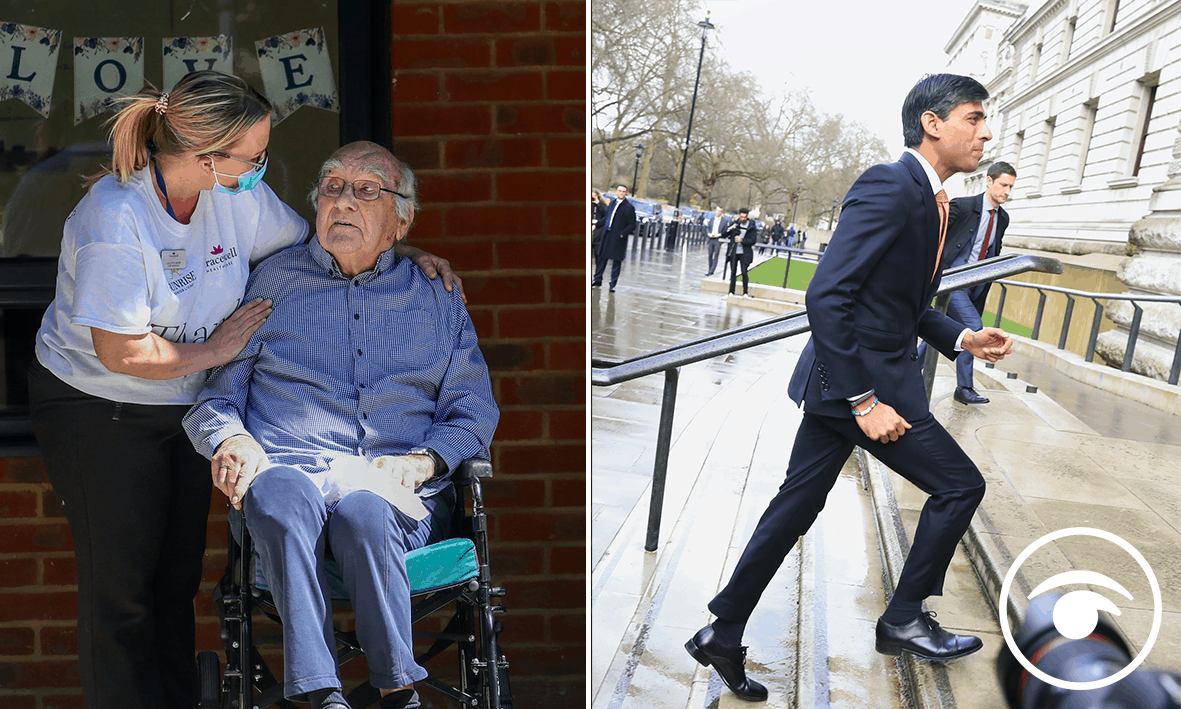UK
Spending review 2020: Five announcements that drew strong reactionsBy Alix Culbertson, news reporter
Wednesday 25 November 2020
SKY NEWS


Image:Rishi Sunak announced the spending review on Wednesday
Rishi Sunak's spending review has elicited strong reactions from across the board as the UK struggles with its biggest fall in output for more than 300 years.
Sky News looks at five key parts of the announcement and what the reaction has been to them.
Overseas aid budget cut from 0.7% to 0.5% of gross national income - about £10bn
Rishi Sunak's spending review has elicited strong reactions from across the board as the UK struggles with its biggest fall in output for more than 300 years.
Sky News looks at five key parts of the announcement and what the reaction has been to them.
Overseas aid budget cut from 0.7% to 0.5% of gross national income - about £10bn
A controversial move among MPs of all parties, especially as the Conservative manifesto promised to not reduce the foreign aid budget.
Mr Sunak said keeping it at 0.7% is "difficult to justify...when we're seeing the highest peacetime levels of borrowing on record".
He added there is the intention to go back to 0.7% when the fiscal climate allows.
The announcement led to the resignation of Foreign Office minister Baroness Sugg, who said it was "fundamentally wrong".
The change moves the UK from the number one foreign aid contributor per GDP to the second - something met with disdain by the world's leading aid agencies.
Save the Children's chief executive, Kevin Watkins, said the chancellor had "broken a promise to the world's poorest people and broken Britain's reputation for leadership on the world stage".
Oxfam's chief executive, Danny Sriskandarajah, said the move "will lead to tens of thousands of otherwise preventable deaths".
Live updates and reaction after Rishi Sunak's spending review
Mr Sunak said keeping it at 0.7% is "difficult to justify...when we're seeing the highest peacetime levels of borrowing on record".
He added there is the intention to go back to 0.7% when the fiscal climate allows.
The announcement led to the resignation of Foreign Office minister Baroness Sugg, who said it was "fundamentally wrong".
The change moves the UK from the number one foreign aid contributor per GDP to the second - something met with disdain by the world's leading aid agencies.
Save the Children's chief executive, Kevin Watkins, said the chancellor had "broken a promise to the world's poorest people and broken Britain's reputation for leadership on the world stage".
Oxfam's chief executive, Danny Sriskandarajah, said the move "will lead to tens of thousands of otherwise preventable deaths".
Live updates and reaction after Rishi Sunak's spending review

Play Video - Foreign aid cut for 'UK jobs and services'
Foreign aid cut for 'UK jobs and services'
In reference to Boris Johnson's recent defence spending increase, he said: "It's a false economy which diverts money from clean water and medicines to pay for bombs and bullets."
Former prime ministers Sir John Major, David Cameron and Tony Blair, and Nobel Prize laureate Malala Yousafzai had urged the government to not cut the foreign aid budget ahead of the spending review
Public sector pay freeze (apart from NHS workers)
The GMB union has criticised the government's plan to "pause" public sector pay.
Nurses, doctors and others in the NHS will get a pay rise but other public sector workers will not.
That includes firefighters, teachers, the armed forces, police, civil servants, council and government agency staff.
The lowest paid public sector staff earning below £24,000 will get an increase of at least £250.

Image:Nurses have been given a pay rise now, but said they would oppose the freeze for social care workers SOLIDARITY!
The Royal College of Nursing has said its members will oppose plans to freeze the pay "of equally skilled professionals" working in the social care sector.
Rehana Azam, national officer of the GMB union, said this will hit key workers "who have risked everything during the pandemic".
This will put the chancellor "on a direct collision course" with public service workers, she added.
£4bn "levelling up" fund for England to finance local infrastructure projects
Communities will be able to bid for cash for projects such as a new bypass, a museum or railway station upgrades.
The caveats were that they must have "real impact", be delivered within this parliament term and have local support, including from the local MP.
This last point was jumped on by shadow chancellor Anneliese Dodds who said the fact MPs had to be involved meant it would not be community driven.

The Royal College of Nursing has said its members will oppose plans to freeze the pay "of equally skilled professionals" working in the social care sector.
Rehana Azam, national officer of the GMB union, said this will hit key workers "who have risked everything during the pandemic".
This will put the chancellor "on a direct collision course" with public service workers, she added.
£4bn "levelling up" fund for England to finance local infrastructure projects
Communities will be able to bid for cash for projects such as a new bypass, a museum or railway station upgrades.
The caveats were that they must have "real impact", be delivered within this parliament term and have local support, including from the local MP.
This last point was jumped on by shadow chancellor Anneliese Dodds who said the fact MPs had to be involved meant it would not be community driven.

Image:Councils will be able to bid for infrastructure funding
"So much for taking back control, this is about the centre handing over support in a very top-down manner," she said.
Questions have been raised over whether this would mean Conservative MPs would be favoured over their Labour counterparts.
Councils to have access to extra £1bn for social care in 2021
The chancellor said this will allow councils to increase core spending by 4.5% and will give them extra flexibility to increase council tax and social care precepts.
It means councils will be able to increase council tax bills by 2% without needing a referendum.
But Caroline Abrahams, charity director at Age UK and co-chair of the CSA (Care and Support Alliance), said the funding was "insufficient" to safeguard current levels of services into next year.
She said it is "hard not to conclude we've gone backwards".
"So much for taking back control, this is about the centre handing over support in a very top-down manner," she said.
Questions have been raised over whether this would mean Conservative MPs would be favoured over their Labour counterparts.
Councils to have access to extra £1bn for social care in 2021
The chancellor said this will allow councils to increase core spending by 4.5% and will give them extra flexibility to increase council tax and social care precepts.
It means councils will be able to increase council tax bills by 2% without needing a referendum.
But Caroline Abrahams, charity director at Age UK and co-chair of the CSA (Care and Support Alliance), said the funding was "insufficient" to safeguard current levels of services into next year.
She said it is "hard not to conclude we've gone backwards".
"Local authorities are once again being asked to square an impossible circle and this ungenerous settlement does very little to help the NHS either," she said.
"However, it's older and disabled people, and their families and carers, who will as ever pay the biggest price, with more likely to have to manage without the support they need.
"This is a bitter pill to swallow, especially after everything social care has been through this year."
Business reacts to spending review - "waste no time"
Industry leaders said the chancellor had taken "bold" decisions" in the spending review, mentioning long-term innovation funding, a plan for creating jobs and a new National Infrastructure Bank.
Rain Newton-Smith, chief economist at the Confederation of Business Industry, said the stark forecasts pointed to "tough times ahead".

High streets have been hit hard during the pandemic
He praised the chancellor for laying "the foundations for a brighter economic future".
But, he said "ambition must be matched by action on the ground" and there "can be no let-up in the support for firms facing new COVID restrictions".
Adam Marshall, director general of the British Chambers of Commerce, also said the government "must waste no time in putting these plans into action".
He praised the chancellor for laying "the foundations for a brighter economic future".
But, he said "ambition must be matched by action on the ground" and there "can be no let-up in the support for firms facing new COVID restrictions".
Adam Marshall, director general of the British Chambers of Commerce, also said the government "must waste no time in putting these plans into action".
Sending Review: ‘Real terms cut for the very people who have carried us through this pandemic’
“There won’t be a ‘pause’ in how much rent, mortgages, food and transport costs.

Britain’s economy will suffer the biggest plunge in output for more than 300 years and government borrowing will balloon to a peacetime high of £394 billion, the fiscal watchdog has warned.
The Office for Budget Responsibility (OBR) said £218 billion of government support to help the economy through the pandemic will see borrowing soar to the equivalent of 19% of gross domestic product (GDP) in 2020-21.
The borrowing marks the highest level in Britain’s peacetime history and a significant hike on the £372.2 billion forecast by the OBR only three months ago.
But Chancellor Rishi Sunak warned the economic damage is likely to be lasting, with the economy around 3% smaller in 2025 than expected in the March Budget.
The OBR said the second national lockdown would dent GDP in November and following months, but the size of the hit would depend on the restrictions that follow.
It said the impact would be less than in the first lockdown, with the fall in GDP expected to be three-fifths that seen during the first lockdown.
In its economic and fiscal outlook, it said: “A resurgence of infections and subsequent tightening of public health restrictions in different parts of the UK took the wind out of the recovery going into fourth quarter.”
The Chancellor announced that NHS doctors and nurses will receive a pay rise, but pay rises in the rest of the public sector will be “paused” next year.
Pay cut
GMB, Britain’s general union, says the Chancellor’s Comprehensive Spending Review today delivers a real terms pay cut for the workers who carried the country through the pandemic
Warren Kenny, GMB Acting General Secretary, said: “There won’t be a ‘pause’ in how much rent, mortgages, food and transport costs.
“The Chancellor couldn’t even bring himself to say the words ‘pay freeze’.
“He’s delivered a real terms cut for the very people who have carried us through this pandemic at great personal expense.
“The same workers whose wages still hadn’t recovered from a decade of so called ‘pay restraint’.
“Punishing public sector workers doesn’t help those in the private sector and it doesn’t help the economy. By trying to divide and conquer he’s letting every worker down.”
RelatedPosts
Long-term economic damage from no-deal Brexit likely to be worse than pandemic, warns Bank of England
$427bn lost annually to tax evasion as UK hands out billions in Covid bailouts to firms based offshore
Long-term economic damage from no-deal Brexit likely to be worse than pandemic, warns Bank of England
$427bn lost annually to tax evasion as UK hands out billions in Covid bailouts to firms based offshore
Spending Review represents kick in the teeth for key workers
November 25th 2020
Workers across Scotland will reject Chancellor’s public/private con trick.
Responding to Rishi Sunak’s Spending Review, Roz Foyer, STUC General Secretary, said:
“This Spending Review is a kick in the teeth to those very same workers Rishi Sunak was clapping months ago.
“Despite thousands of workers in the private sector surviving on furlough pay at 80%, Rishi Sunak choose to attack public sector pay. This is a levelling down agenda, not a levelling up one.
“Very few people will be fooled by his attempts to pit care workers against shop workers or low paid council workers against low paid cleaners. All need a decent pay increase, and they all need it now. If the Chancellor wants to equalise public sector and private sector pay, he should have ensured that workers cannot be furloughed on less than the minimum wage and increased the minimum wage to at least £10 per hour. 18 pence on the minimum wage is pennies, when we need pounds.
“£250 for lower paid public sector workers is the exact same policy introduced by George Osborne in 2010 and still amounts to a pay cut for many.”
Foyer also criticised other funding announcements:
“This was the moment to announce a massive fiscal stimulus to drive a green recovery and the Chancellor totally missed it. While we await details for the new National Infrastructure Bank and funding for the devolved administrations, the figures announced come nowhere near the amount needed.
“Moreover, instead of devolving funding and power to local communities, the Levelling Up Fund centralises control in Whitehall and enables the Treasury to pick and choose which pet projects it will support.
“Cutting international development funding to 0.5% of GDP shows that for all its talk of global Britain, this Government doesn’t really care for world’s most vulnerable.
“The Chancellor’s statement also did nothing to address the gaping holes in our social safety net. With unemployment likely to rise to 7.6% next year, the Government must commit, as a minimum, to continuing the £20 uplift in Universal Credit so people can weather that storm while they look for work.
“Workers in Scotland know that key workers deserve a pay rise. They will see through Rishi Sunak’s con trick.”
November 25th 2020
Workers across Scotland will reject Chancellor’s public/private con trick.
Responding to Rishi Sunak’s Spending Review, Roz Foyer, STUC General Secretary, said:
“This Spending Review is a kick in the teeth to those very same workers Rishi Sunak was clapping months ago.
“Despite thousands of workers in the private sector surviving on furlough pay at 80%, Rishi Sunak choose to attack public sector pay. This is a levelling down agenda, not a levelling up one.
“Very few people will be fooled by his attempts to pit care workers against shop workers or low paid council workers against low paid cleaners. All need a decent pay increase, and they all need it now. If the Chancellor wants to equalise public sector and private sector pay, he should have ensured that workers cannot be furloughed on less than the minimum wage and increased the minimum wage to at least £10 per hour. 18 pence on the minimum wage is pennies, when we need pounds.
“£250 for lower paid public sector workers is the exact same policy introduced by George Osborne in 2010 and still amounts to a pay cut for many.”
Foyer also criticised other funding announcements:
“This was the moment to announce a massive fiscal stimulus to drive a green recovery and the Chancellor totally missed it. While we await details for the new National Infrastructure Bank and funding for the devolved administrations, the figures announced come nowhere near the amount needed.
“Moreover, instead of devolving funding and power to local communities, the Levelling Up Fund centralises control in Whitehall and enables the Treasury to pick and choose which pet projects it will support.
“Cutting international development funding to 0.5% of GDP shows that for all its talk of global Britain, this Government doesn’t really care for world’s most vulnerable.
“The Chancellor’s statement also did nothing to address the gaping holes in our social safety net. With unemployment likely to rise to 7.6% next year, the Government must commit, as a minimum, to continuing the £20 uplift in Universal Credit so people can weather that storm while they look for work.
“Workers in Scotland know that key workers deserve a pay rise. They will see through Rishi Sunak’s con trick.”
Bedford nurses demand pay rise in letters to MPs ahead of expected public sector pay freeze
The Royal College of Nursing wants a 12.5 per cent pay rise for nurses
By Clare Turner
Wednesday, 25th November 2020, 2:18 pm
Bedford nurses are among hundreds in the East of England to call on Chancellor Rishi Sunak to increase their pay as part of a spending review this week.
The Royal College of Nursing (RCN) wants a 12.5 per cent pay rise for nurses, claiming members feel “undervalued” and that they are being driven out by “poor pay levels”.
Mr Sunak is expected to impose a public sector pay freeze in his Spending Review this week, but it is understood NHS nurses and doctors could be exempt.

The RCN says the Covid-19 pandemic, combined with staffing shortages, has shown the public how deserving nurses are of “fair pay”.
NHS figures for June this year show the vacancy rate for nurses in the East of England was 9 per cent, down from 9.3 per cent in March.
The RCN, which wants the 12.5 per cent% pay rise for all nursing staff, is holding a virtual rally in support of its Fair Pay for Nursing campaign.
Chief executive and general secretary Dame Donna Kinnair said: “There isn’t an MP across the UK who can say they haven’t heard of our aim.
“The sheer numbers of people who have written, asking for politicians’ support, shows the high esteem in which the public holds nursing staff.
“Even though nursing staff have tackled a global pandemic with 50,000 nursing vacancies in the NHS across the UK, the Government continues to undervalue them.
“It can’t hope to fill staffing shortages with our current poor pay levels.
"The Chancellor must make the right decision."
On Sunday, Mr Sunak hinted he could impose a public sector pay freeze as part of his spending review by arguing it would be “entirely reasonable” to consider pay policy in an economy ravaged by the coronavirus pandemic.
Treasury sources have suggested that pay for NHS staff, including nurses and doctors, will be dealt with separately.
Mr Sunak also said £3 billion has been earmarked to support the NHS in recovering from the pandemic, including money to address backlogs caused by Covid-19.
By Clare Turner
Wednesday, 25th November 2020, 2:18 pm
Bedford nurses are among hundreds in the East of England to call on Chancellor Rishi Sunak to increase their pay as part of a spending review this week.
The Royal College of Nursing (RCN) wants a 12.5 per cent pay rise for nurses, claiming members feel “undervalued” and that they are being driven out by “poor pay levels”.
Mr Sunak is expected to impose a public sector pay freeze in his Spending Review this week, but it is understood NHS nurses and doctors could be exempt.

The Royal College of Nursing wants a 12.5 per cent pay rise for nurses
Across Bedford’s three constituencies, 57 RCN members have written to their MPs calling for a pay increase in recognition of their work.
The breakdown of letters from RCN members in each constituency from November 23 is:
Mid Bedfordshire: 29
Bedford: 16
North East Bedfordshire: 12
Across the East of England, 1,283 RCN members have written to their MPs, as well as 86 non-members.
They help make up the 15,833 who have written to their MP nationally.
Across Bedford’s three constituencies, 57 RCN members have written to their MPs calling for a pay increase in recognition of their work.
The breakdown of letters from RCN members in each constituency from November 23 is:
Mid Bedfordshire: 29
Bedford: 16
North East Bedfordshire: 12
Across the East of England, 1,283 RCN members have written to their MPs, as well as 86 non-members.
They help make up the 15,833 who have written to their MP nationally.
The RCN says the Covid-19 pandemic, combined with staffing shortages, has shown the public how deserving nurses are of “fair pay”.
NHS figures for June this year show the vacancy rate for nurses in the East of England was 9 per cent, down from 9.3 per cent in March.
The RCN, which wants the 12.5 per cent% pay rise for all nursing staff, is holding a virtual rally in support of its Fair Pay for Nursing campaign.
Chief executive and general secretary Dame Donna Kinnair said: “There isn’t an MP across the UK who can say they haven’t heard of our aim.
“The sheer numbers of people who have written, asking for politicians’ support, shows the high esteem in which the public holds nursing staff.
“Even though nursing staff have tackled a global pandemic with 50,000 nursing vacancies in the NHS across the UK, the Government continues to undervalue them.
“It can’t hope to fill staffing shortages with our current poor pay levels.
"The Chancellor must make the right decision."
On Sunday, Mr Sunak hinted he could impose a public sector pay freeze as part of his spending review by arguing it would be “entirely reasonable” to consider pay policy in an economy ravaged by the coronavirus pandemic.
Treasury sources have suggested that pay for NHS staff, including nurses and doctors, will be dealt with separately.
Mr Sunak also said £3 billion has been earmarked to support the NHS in recovering from the pandemic, including money to address backlogs caused by Covid-19.
Dozens of Reading nurses call on government for pay rise
By Olivia Gantzer @oliviagantzerSenior News Reporter

READING nurses are among hundreds in the South East to call on Chancellor Rishi Sunak to increase their pay as part of a spending review this week.
The Royal College of Nursing (RCN) wants a 12.5 per cent pay rise for nurses, claiming members feel “undervalued” and that they are being driven out by “poor pay levels”.
Mr Sunak is expected to impose a public sector pay freeze in his Spending Review this week, but i is understood NHS nurses and doctors could be exempt.
Across Reading's two constituencies, 48 RCN members have written to their MPs calling for a pay increase in recognition of their work.
The breakdown of letters from RCN members in each constituency from November 23 is:
Reading East: 26
Reading West: 22
Across the South East, 1,679 RCN members have written to their MPs, as well as 82 non-members.
They help make up the 15,833 who have written to their MP nationally.
The RCN says the Covid-19 pandemic, combined with staffing shortages, has shown the public how deserving nurses are of “fair pay”.
NHS figures for June this year show the vacancy rate for nurses in the South East was 11 per cent, up from 9.9 per cent in March.
The RCN, which wants the 12.5 per cent pay rise for all nursing staff, is holding a virtual rally in support of its Fair Pay for Nursing campaign.
Chief executive and general secretary Dame Donna Kinnair said: “There isn’t an MP across the UK who can say they haven’t heard of our aim.
“The sheer numbers of people who have written, asking for politicians’ support, shows the high esteem in which the public holds nursing staff.
“Even though nursing staff have tackled a global pandemic with 50,000 nursing vacancies in the NHS across the UK, the Government continues to undervalue them.
“It can’t hope to fill staffing shortages with our current poor pay levels.
"The Chancellor must make the right decision."
On Sunday, Mr Sunak hinted he could impose a public sector pay freeze as part of his spending review by arguing it would be “entirely reasonable” to consider pay policy in an economy ravaged by the coronavirus pandemic.
Treasury sources have suggested that pay for NHS staff, including nurses and doctors, will be dealt with separately.
Mr Sunak also said £3 billion has been earmarked to support the NHS in recovering from the pandemic, including money to address backlogs caused by Covid-19.
By Olivia Gantzer @oliviagantzerSenior News Reporter

READING nurses are among hundreds in the South East to call on Chancellor Rishi Sunak to increase their pay as part of a spending review this week.
The Royal College of Nursing (RCN) wants a 12.5 per cent pay rise for nurses, claiming members feel “undervalued” and that they are being driven out by “poor pay levels”.
Mr Sunak is expected to impose a public sector pay freeze in his Spending Review this week, but i is understood NHS nurses and doctors could be exempt.
Across Reading's two constituencies, 48 RCN members have written to their MPs calling for a pay increase in recognition of their work.
The breakdown of letters from RCN members in each constituency from November 23 is:
Reading East: 26
Reading West: 22
Across the South East, 1,679 RCN members have written to their MPs, as well as 82 non-members.
They help make up the 15,833 who have written to their MP nationally.
The RCN says the Covid-19 pandemic, combined with staffing shortages, has shown the public how deserving nurses are of “fair pay”.
NHS figures for June this year show the vacancy rate for nurses in the South East was 11 per cent, up from 9.9 per cent in March.
The RCN, which wants the 12.5 per cent pay rise for all nursing staff, is holding a virtual rally in support of its Fair Pay for Nursing campaign.
Chief executive and general secretary Dame Donna Kinnair said: “There isn’t an MP across the UK who can say they haven’t heard of our aim.
“The sheer numbers of people who have written, asking for politicians’ support, shows the high esteem in which the public holds nursing staff.
“Even though nursing staff have tackled a global pandemic with 50,000 nursing vacancies in the NHS across the UK, the Government continues to undervalue them.
“It can’t hope to fill staffing shortages with our current poor pay levels.
"The Chancellor must make the right decision."
On Sunday, Mr Sunak hinted he could impose a public sector pay freeze as part of his spending review by arguing it would be “entirely reasonable” to consider pay policy in an economy ravaged by the coronavirus pandemic.
Treasury sources have suggested that pay for NHS staff, including nurses and doctors, will be dealt with separately.
Mr Sunak also said £3 billion has been earmarked to support the NHS in recovering from the pandemic, including money to address backlogs caused by Covid-19.







